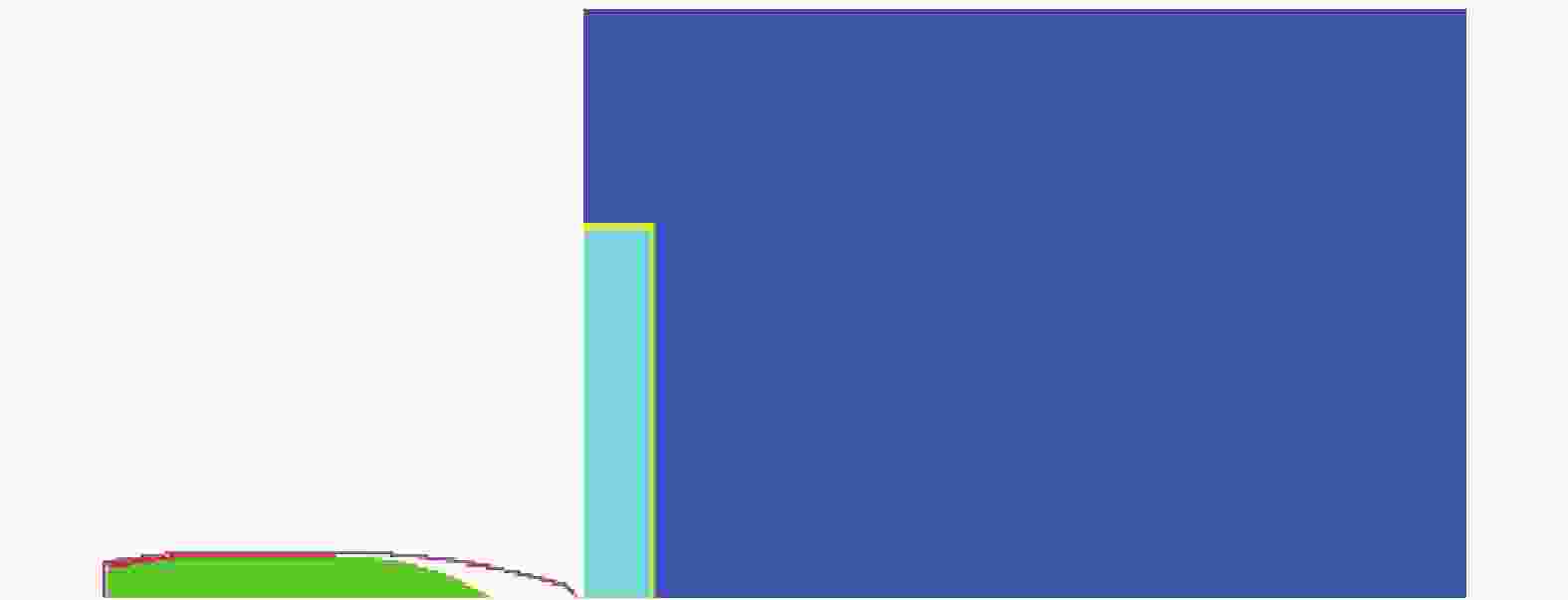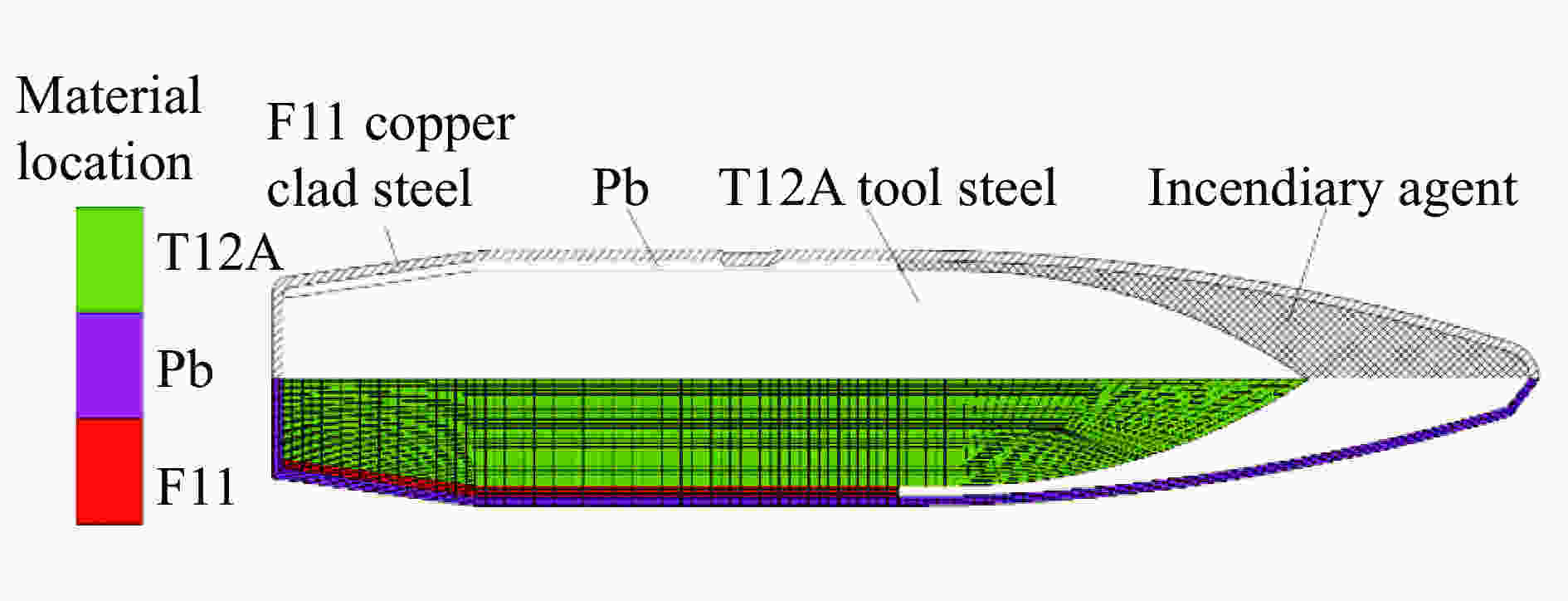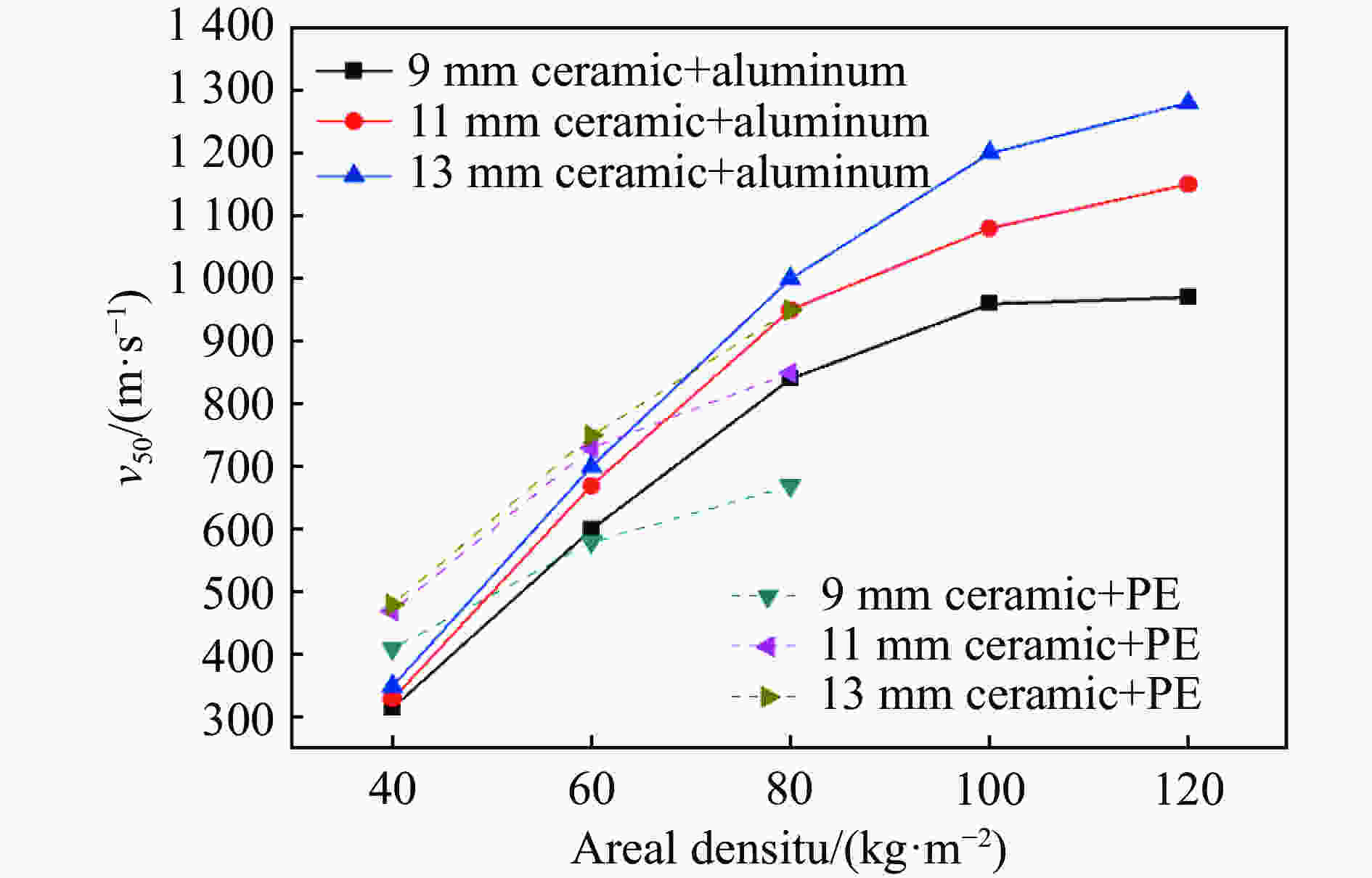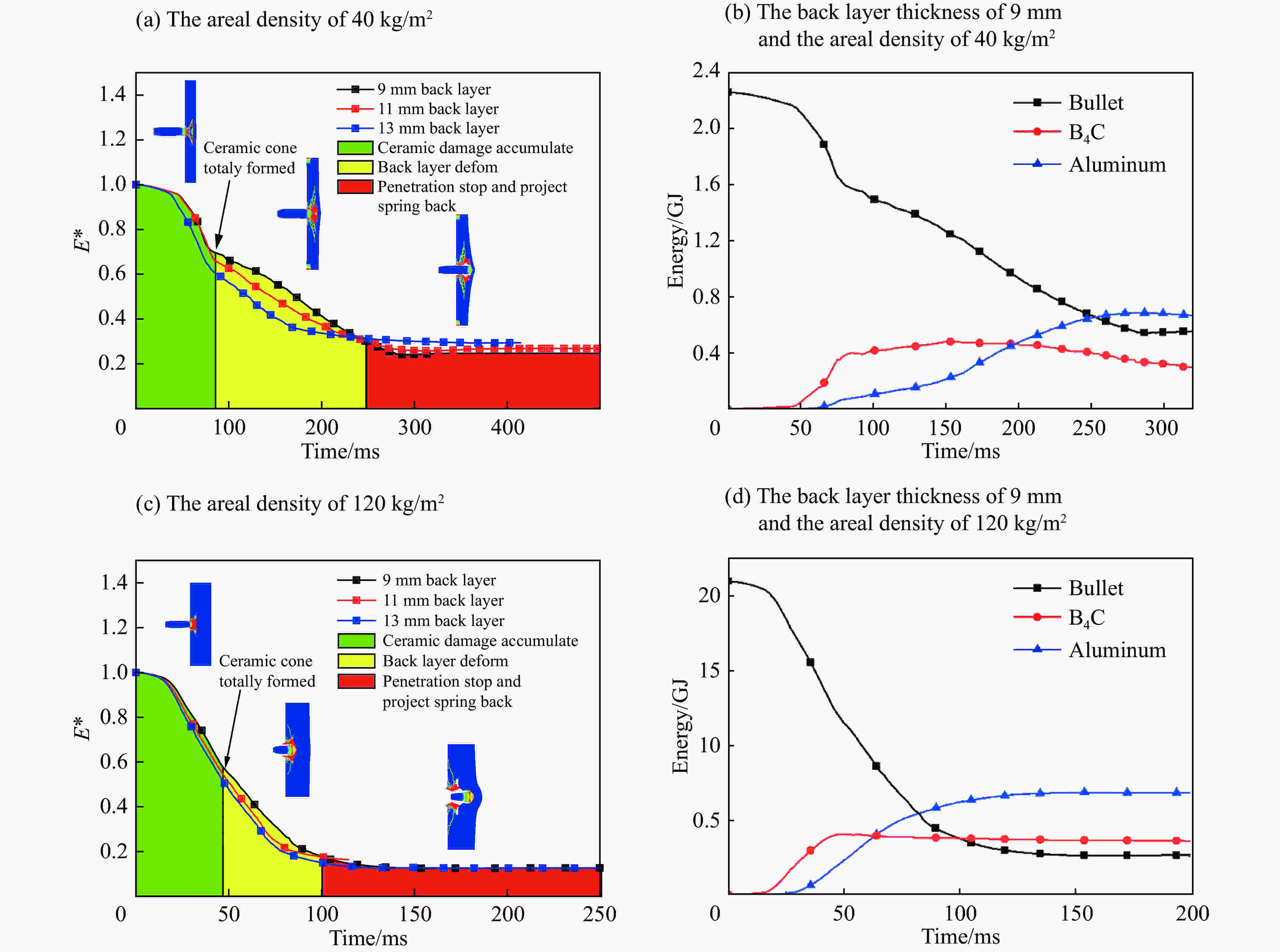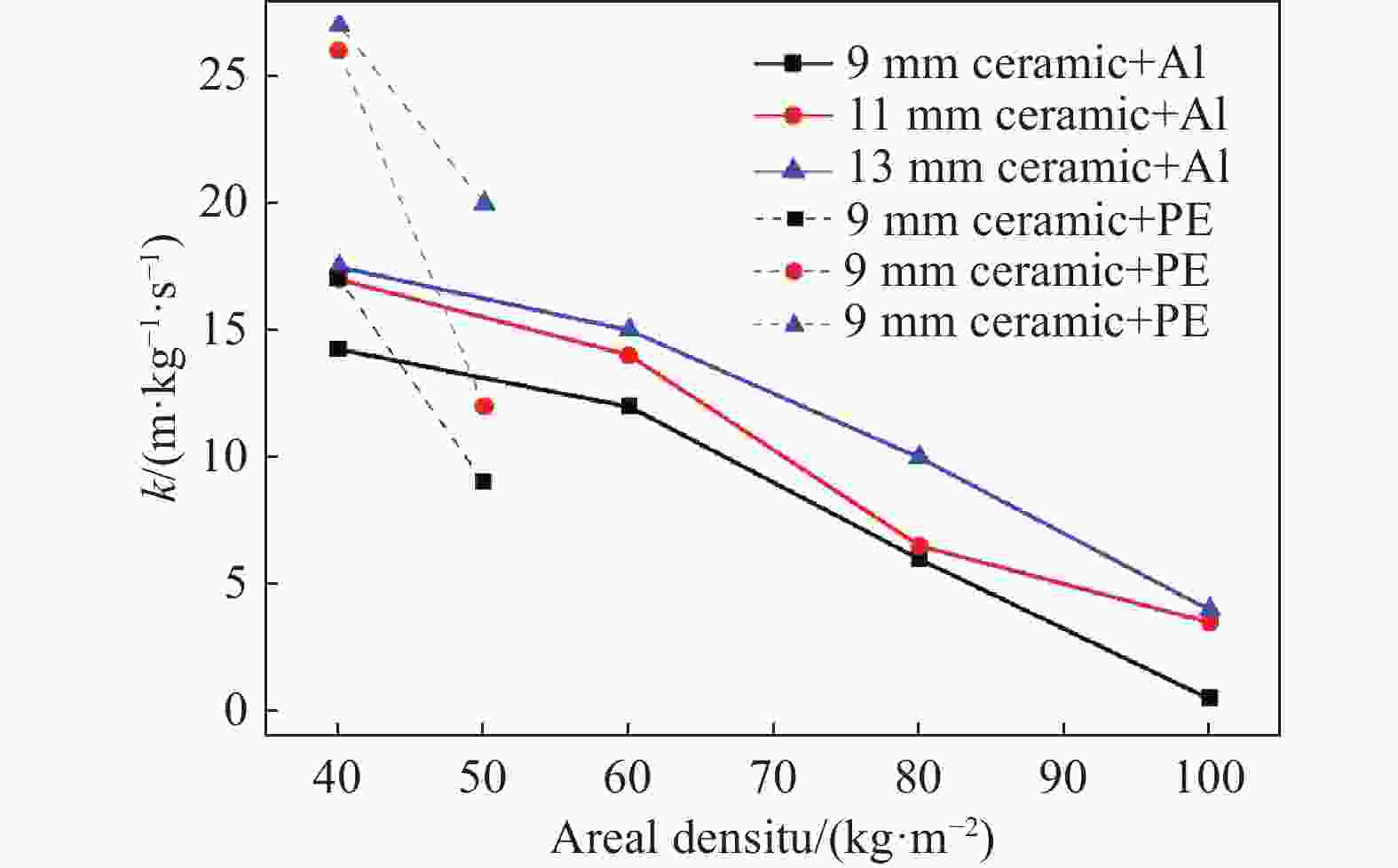Ballistic test and numerical simulation on penetration of a boron-carbide-ceramic composite target by a bullet
-
摘要: 碳化硼陶瓷具有高硬度、低密度的特性,在装甲防护领域有广泛的应用前景,碳化硼陶瓷及其复合靶的冲击破坏特性是装甲防护领域近期的焦点问题之一。本文中基于剩余穿深方法,开展了碳化硼及复合靶抗12.7 mm穿甲燃烧弹侵彻的试验研究。建立了碳化硼陶瓷复合靶抗弹数值模拟模型,根据试验研究结果验证数值模拟方法的可靠性。在此基础上,开展了12.7 mm穿甲燃烧弹侵彻碳化硼陶瓷复合靶的数值模拟研究,重点研究了靶板配置、背板厚度及种类对复合靶抗弹性能的影响。结果表明:靶板面密度相同的情况下,随着陶瓷厚度的增大,陶瓷复合靶的抗弹性能提高;陶瓷厚度相同时,陶瓷复合靶抗弹性能提升的效率随其面密度的增大而下降。陶瓷/PE (polyethylene)结构适合抵抗低速弹体的侵彻破坏,陶瓷/铝结构适合抵抗高速弹体的侵彻破坏。Abstract: Boron carbide (B4C) ceramic has been widely used in armor fence due to its high hardness and low density. Ballistic performance of B4C ceramic and its composite targets has been one of the focuses recently. Ballistic performance of B4C ceramic composite targets defending 12.7 mm calibre armor-piercing bullets were explored through depth-of-penetration experiments and the corresponding numerical simulation model was established. The numerical simulation model for 12.7 mm calibre armor-piercing bullets penetrating into B4C ceramic composite targets was verified through the comparison between numerical results and experimental data. The influences of target configuration, back layer thickness and type on the ballistic performance of the composite targets were explored. It can be figured out from the results that for the composite targets with same areal density, the thicker the ceramic target, the better its ballistic performance; the increasing rate in the ballistic performance of the ceramic composite target decreases when the areal density increases and the ceramic thickness keeps constant. Ceramic/polyethylene (PE) structures are more suitable for defending against penetration by low-velocity bullets, while ceramic/Al structures are more suitable for defending against penetration by high-velocity bullets.
-
表 1 12.7 mm 口径穿甲燃烧弹侵彻铝靶的试验数据
Table 1. Experimental data for 12.7 mm armor-piercing explosive incendiary bullets penetrating into aluminum targets
弹丸速度/(m·s−1) 侵彻深度/mm 侵彻深度平均值/mm 834 78 826 73 75.3 845 75 表 2 12.7 mm 穿燃弹侵彻陶瓷复合靶的速度和深度
Table 2. Velocities and depths of 12.7 mm armor-piercing explosive incendiary bullets penetrating ceramic composite targets
靶体 速度/(m·s−1) 铝背板侵彻深度/mm 防护系数 碳化硼陶瓷半无限复合靶 836 6 5.3 820 5 5.7 120 kg/m2面密度复合靶 831 24 2.3 823 18 2.9 表 3 12.7 mm 穿燃弹与后效铝靶材料本构参数
Table 3. Parameters of the JC constitutive model for the 12.7 mm armor-piercing explosive incendiary bullet and the witness target
材料 ρ/(kg·m−3) A/MPa B/MPa n C m 2A12铝合金 2 750 330 445 0.709 0.012 1.0 F11 7 920 300 275 0.15 0.022 1.09 T12A 7 850 1 540 477 0.16 0 1 表 4 碳化硼陶瓷材料本构参数
Table 4. Parameters of the constitutive model for B4C
ρ/(kg·m−3) K1/GPa K2/GPa K3/GPa T/GPa A N 2 510 233 −593 2 800 0.26 0.927 0.67 C B M $\sigma _{{\rm{f}},{\rm{max}}}^*$ D1 D2 β 0.005 0.7 0.85 0.5 0.001 0.5 1.0 -
[1] WILKINS M L, LANDINGHAM R L, HONODEL C A. Light-armor program. Fifth progress report: UCR L-50980 [R]. USA: Lawrence Livermore national Laboratory, 1971. [2] JOHNSON G R, HOLMQUIST T J. Response of boron carbide subjected to large strains, high strain rates, and high pressures [J]. Journal of Applied Physics, 1999, 85(12): 8060–8073. DOI: 10.1063/1.370643. [3] HOLMQUIST T J, JOHNSON G R. Response of boron carbide subjected to high-velocity impact [J]. International Journal of Impact Engineering, 2008, 35(8): 742–752. DOI: 10.1016/j.ijimpeng.2007.08.003. [4] GRADY D E. Shock-wave strength properties of boron carbide and silicon carbide [J]. Le Journal De Physique IV, 1994, 4(C8): 385–391. DOI: 10.1051/jp4:1994859. [5] WESTERLING L, LUNDBERG P, LUNDBERG B. Tungsten long-rod penetration into confined cylinders of boron carbide at and above ordnance velocities [J]. International Journal of Impact Engineering, 2001, 25(7): 703–714. DOI: 10.1016/S0734-743X(00)00072-5. [6] ORPHAL D L, FRANZEN R R, CHARTERS A C, et al. Penetration of confined boron carbide targets by tungsten long rods at impact velocities from 1.5 to 5.0 km/s [J]. International Journal of Impact Engineering, 1997, 19(1): 15–29. DOI: 10.1016/S0734-743X(96)00004-8. [7] WILKINS M L. Second progress report of light amour program: UCRL-50349 [R]. USA: Lawrence Livermore Laboratory Report, 1967. [8] WILKINS M L. Third progress report of light amour program: UCRL-50460 [R]. USA: Lawrence Livermore Laboratory Report, 1968. [9] 卢君, 陈斌, 曾首义. 7.62 mm口径模拟弹侵彻碳化硼陶瓷复合靶板的数值模拟[C] // 第19届全国结构工程学术会议论文集. 济南, 2010: 116−120. [10] 孙炜海, 鞠桂玲, 杨班权. 平头弹丸侵彻B4C陶瓷/金属复合靶板的数值模拟 [J]. 装甲兵工程学院学报, 2014, 28(1): 45–48. DOI: 10.11732/j.issn.1672-1497.2014.01.010.SUN Weihai, JU Guiling, YANG Banquan. Numerical simulation on penetration of B4C ceramic/metal composite targets struck by flat-ended projectiles [J]. Journal of Academy of Armored Force Engineering, 2014, 28(1): 45–48. DOI: 10.11732/j.issn.1672-1497.2014.01.010. [11] ANDERSON Jr C E, BURKINS M, WALKER J, et al. Time-resolved penetration of B4C tiles by the APM2 bullet [J]. Computer Modeling in Engineering and Sciences, 2005, 8(2): 91–104. DOI: 10.1525/ae.1983.10.2.02a00140. [12] GOOCH W A, BURKINS M S, HAUVER G, et al. Dynamic X-ray imaging of the penetration of boron carbide [J]. Le Journal De Physique IV, 2000, 10: 583–588. [13] STRASSBURGER E, BAUER S. Analysis of the interaction of projectiles with ceramic targets by means of flash X-ray cinematography and optical methods [C] // Proceedings of the 41st International Conference on Advanced Ceramics and Composites. Hoboken, NJ, USA: John Wiley & Sons Inc, 2018: 205−219. DOI: 10.1002/9781119474678.ch20. [14] JOHNSON G R, COOK W H, JOHNSON G, et al. A constitutive model and data for materials subjected to large strains, high strain rates, and high temperatures [C] // Proceedings of the 7th International Symposium on Ballistics. The Hague, Netherlands, 1983: 541−547. [15] 侯二永. 陶瓷间隙靶抗12.7 mm穿甲燃烧弹机理及性能研究[D]. 长沙: 国防科学技术大学, 2008: 16−17. DOI: 10.7666/d.y1523731. [16] 张伟, 魏刚, 肖新科. 2A12铝合金本构关系和失效模型 [J]. 兵工学报, 2013, 34(3): 276–282. DOI: 10.3969/j.issn.1000-1093.2013.03.004.ZHANG Wei, WEI Gang, XIAO Xinke. Constitutive relation and fracture criterion of 2A12 aluminum alloy [J]. Acta Armamentarii, 2013, 34(3): 276–282. DOI: 10.3969/j.issn.1000-1093.2013.03.004. [17] 李春雷. 2A12铝合金本构关系实验研究[D]. 哈尔滨: 哈尔滨工业大学, 2006: 42.LI Chunlei. Experimental investigation into the constitutive relationship of 2A12 aluminum alloy[D]. Harbin: Harbin Institute of Technology, 2006: 42. [18] 唐恩凌, 施晓涵, 王猛, 等. 高速碰撞下圆柱壳自由梁的穿孔特性 [J]. 爆炸与冲击, 2016, 36(1): 121–128. DOI: 10.11883/1001-1455(2016)01-0121-08.TANG Enling, SHI Xiaohan, WANG Meng, et al. Perforation characteristics of cylindrical shell free beam under high-speed impact [J]. Explosion and Shock Waves, 2016, 36(1): 121–128. DOI: 10.11883/1001-1455(2016)01-0121-08. [19] JOHNSON G R, HOLMQUIST T J. An improved computational constitutive model for brittle materials [C] // AIP Conference Proceedings, 1994, 309(1). DOI: 10.1063/1.46199. [20] 谭华. 实验冲击波物理[M]. 北京: 国防工业出版社, 2018: 78−87. -







 下载:
下载:





